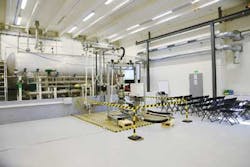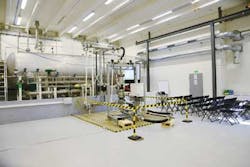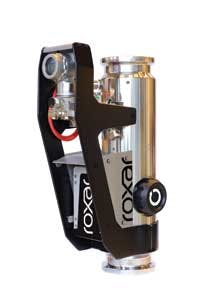Reservoir conditions, flow regimes challenge measurement accuracy-full
Lars Anders Ruden
Emerson Process Measurement
The growth in subsea and topside multi-phase meters over the last few years is such that they have become an essential element of production and monitoring systems for many current offshore installations.
Further growth is also expected. Industry analyst Douglas-Westwood predicts a 90% growth in deepwater expenditure between 2012 and 2016, and up to a thousand additional meters worldwide. Emerson expects the number of new subsea trees coming onstream each year to increase from 280 in 2011 to around 720 in 2016. Many of these trees will include multi-phase meters.
A recent report on multi-phase meters by ARC Advisory Group says that "energy companies such as Statoil, PDVSA, BP, and Petrobras are deploying multi-phase flowmeters on a broad scale to be able to continuously measure the individual components in co-mingled oil, gas, and water streams."
Multi-phase meters play an increasingly important role – from royalty and fiscal allocation to production control, prevention of water encroachment, and the generation of real-time well data to help diagnose and optimize well performance.
Yet, as multi-phase meters continue to increase their market penetration, more challenges arise. These include meter use in more geologically complex and remote fields; the need to manage costs while optimizing production; and the environmental concerns of nucleonic sources – an important element of many traditional multi-phase meters.
Influence quantities
One of the biggest challenges facing multi-phase meters today, however, is the huge variety of reservoir conditions and flow regimes faced when in operation. Accuracy in water production, for example, is becoming more important in detecting formation water and producing injected seawater, and there is a need to measure the process flow over the entire range of the gas volume fraction (GVF) from 0-100%.
While multi-phase meter performance is measured by outputs and the ability to accurately track the flow rates of oil, gas and water, it is equally important to focus on those elements surrounding multi-phase meter deployment that are not measured, yet have a significant impact on the meter's readings. These are called "influence quantities."
Influence quantities are common in many current oil and gas fields and include everything from H2S, CO2, and sand through to hydrate inhibitors, such as MEG (monoethylene glycol), additives such as emulsifiers, wax inhibitors and corrosion inhibitors, and a variety of different flow regimes. The result is a flow stream consisting of multiple influence quantities.
To determine how influence quantities affect multi-phase meter measurements, it is necessary to calculate sensitivity coefficients.
Sensitivity coefficients provide data on how the output estimate varies based on changes in the value of the influence quantity – how one estimate is influenced by small changes in a different estimate.
For example, if an x% change in oil density gives a y% change in oil rate, then the changes of x% and y% are the sensitivity coefficients. The oil density is the influence quantity, and the oil rate is the measurand from the multi-phase meter.
With a better understanding of influence quantities and sensitivity coefficients, operators can better quantify uncertainty in their multi-phase measurements to better manage and plan field development and reservoir management strategies.
Handling complex flow
Multi-phase meters perform in a huge variety of flow regimes that might include bubble, slug, mist, churn, and annular. Slip flow also occurs regularly when gas rises faster than liquid, due to buoyancy effects and the velocity profile of the flow in the pipe.
To handle multiple and rapid changing flow regimes, a sufficient number of sensors and calculations must be included within the meter. For annular flows with high gas fractions, compensation must be incorporated into the gamma system to get accurate measurements.
For rapidly changing slug flows (both water and gas slugs), fast front-end electronics that can capture these changes are important. The third generation Roxar Multi-phase Flow Meter from Emerson, for example, includes high-resolution sensors capable of capturing small changes in the electrical properties of the multi-phase fluid passing through.
Phase slip also varies with changes in process conditions and flow regimes. Some multi-phase systems can only form an estimation of the slip based on flow regime assumptions accessing complex slip models. With the Roxar meter however, the meter's dual-velocity system and cross-correlation capabilities provide flow regime independent measurements.
The direct measurement of the degree of annularity, the mapping of non-symmetrical flow, and a cross-sectional breakdown of the flow are other areas where technology developments are taking place to reduce influences on accuracy.
Salinity and conductivity
Measuring water conductivity and salinity also is increasingly important in the operation of multi-phase meters. Salinity is viewed as a key operational parameter for reservoir management and flow assurance with salinity measurements telling the reservoir engineer whether formation water is entering the flow, and helping the process engineer adjust injection rates of scale and corrosion inhibitors.
In water continuous flow, multi-phase meters are also dependent on an input of water conductivity/salinity values to achieve their correct performance specifications. While variations in water salinity have no influence on the Roxar multi-phase meter's measurements in process conditions at less than ~60 water/liquid ratio WLR (i.e. oil continuous flows), at higher water cuts the water conductivity is an important input value to any multi-phase meter with significant sensitivity coefficients.
For example, with a GVF at 80%, WLR at 60%, and a water conductivity change at +1% rel, the additional uncertainty would be a liquid rate (% rel) at -0.1 % and WLR (% abs) at +0.6%.
Taking these influence quantities into account, Emerson has developed two dedicated salinity/conductivity sensors for operation in multi-phase and wet gas flow and that enable absolute measurements of produced water salinity. The wet gas probe measures salinity in wet gas and high GVFs and the multi-phase probe measures salinity in water continuous multi-phase flow.
The dedicated salinity sensor for multi-phase flow is based on microwave transmissions and can operate in three-phase gas-liquid flows. The sensor measures the effect of the flow on the propagation of the microwave signal in the volume between three probes, with the salinity of the water phase and the local water/liquid ratio then able to be deduced. The result is a better quantification of uncertainty and improved meter measurements.
Handling MEG injection
Operators face threats to flow assurance and multi-phase meter performance from hydrates – the crystals that are formed in high-pressure and low-temperature gas flows where water and natural gas are present.
The growth in deepwater wells with high GVFs, high pressures, and low temperatures increase this threat, with gas hydrates the most common form of downhole blockage. For multi-phase flows, issues include formation of waxes, hydrates and scales; restrictions and blockages; and corrosion and damage of equipment.
While thermodynamic inhibitors such as methanol and ethylene glycol (MEG) are currently the most effective ways to prevent hydrates, they add measurement challenges of their own for multi-phase meters.
MEG is measured as water by the electrical impedance sensor system of the multi-phase meter. The densities of these fluids are lower than water, so the density of the mixed flow can be reduced and, if a considerable amount of MEG is injected, could influence measurements from the gamma system.
To meet this circumstance, either subtract the MEG injection rate from the reported water rate from the multi-phase meter or provide water density input into the multi-phase meter. In this way, measurements can be updated that account for the combined density of the expected water production and MEG/Methanol injection, thereby removing the influence quantity effect on the gamma system.
Conclusion
In all these and other cases of influence quantities, it is important to understand that different multi-phase metering technologies may be affected differently. Understanding influence quantities, sensitive coefficients, and how they are being addressed, should be key elements of the selection process.


